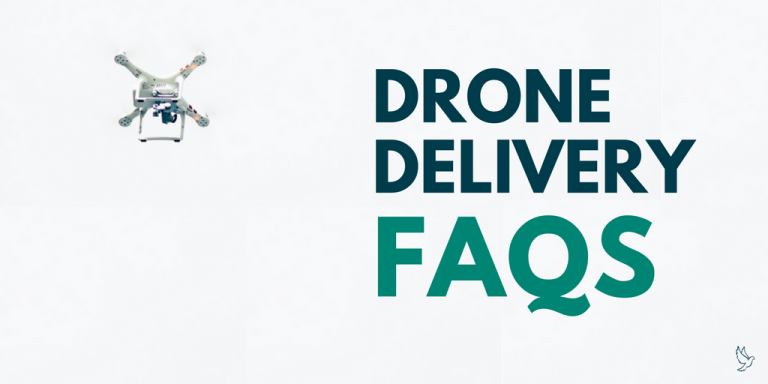What is Drone Delivery? (And Other FAQs)

September 27, 2017
What is drone delivery? What are the risks, benefits, and costs of having your parcels delivered by drone? Here are some of the most frequently asked questions relating to the future of parcel delivery, and their answers.
Q: What is drone delivery?
A: Drone delivery, or delivery by commercial drone, refers to the use of UAVs (Unmanned Aerial Vehicles) or RPAS (Remotely Piloted Aircraft Systems) for means of parcel dispatch and delivery. As such, all uses of the terms ‘drones’ and ‘drone delivery’ within this article will be referring to commercial UAVs.
Q: How does it work?
A: Drone delivery is currently being implemented under a number of different models. Some companies, notably Amazon, are interested in using UAVs to deliver goods direct to the customer’s doorstep. You can watch how Amazon envision their concept working in this PrimeAir promo video. However, others such as DHL are looking to use drone technology to transfer parcels between fixed locations, whilst using traditional means of transport to complete the delivery to the customer. Drone delivery is even being pioneered by humanitarian organisations such as Zipline to help deliver aid to remote destinations.
In the UK, it is most likely that drone delivery will initially operate under a fixed-point delivery model. Parcels will be moved from a fixed destination to another along a flight corridor, where delivery vans will be used to undertake what is referred to as the ‘last mile’ delivery.
Q: What are the benefits?
A: Delivery by drone is likely to be a cheaper and quicker means of delivery to remote locations when compared to traditional means of transport. Capable of reaching high airspeeds and not bound by ground infrastructure and traffic, drones offer a high-speed delivery solution. UAVs fly autonomously and so have very low operating costs, making them an efficient and cost-effective method of delivery. Furthermore, UAVs are normally battery, electric, or solar-powered, and therefore offer an environmentally-friendly and zero-emissions delivery solution.
Q: What are the risks?
A: Whilst autonomy is a major benefit of drone technology, it can also be seen as a risk. Cybersecurity flaws – if present – could result in the remote hijacking or hacking of the craft. UAVs will have to navigate and avoid other lower-altitude craft such as helicopters and be prevented from flying near airports. Some delivery models that propose using UAVs to deliver to built-up areas such as towns and cities are more high-risk as there are more obstacles and variables for drones to negotiate in order to complete their deliveries. By contrast, deliveries to remote locations are likely to be much less risky.
It is worth noting that delivery drones will be strictly regulated in order to mitigate risks as far as is possible. Under current regulations, drones are not permitted to fly beyond line of sight or autonomously. However, as drone delivery becomes increasingly feasible, these regulations are likely to change to accommodate such services.
Q: How will it be regulated?
A: In the UK, the Civil Aviation Authority (CAA), working with industry and developers of UAV technology, will outline regulations and specifications for the use of drones for delivery. Regulations are likely to detail how UAVs should be developed, tested and secured. They are also likely to outline where and when they can fly, in addition to how services should be run. It is likely that, to begin with, delivery drones will only be permitted to fly along certified flight routes between fixed points, much like other commercial aircraft.
Q: What kinds of things might drones deliver?
A: The average UAV can typically transport a payload of around 2kg, though larger craft can carry anything up to 25kg. Whilst current CAA regulations state that a small UAV and its payload must not exceed 20kg in mass, in the near future, UAVs could be used to transport a wide variety of goods. Documents, clothes, and other small or medium-sized and weighted items are just a few examples.
Q: How much will it cost?
A: Costs for drone delivery will vary depending on the items you wish to transport, whether or not you require expedited delivery, and the courier you decide to use. Most couriers that are currently considering adopting drone delivery are looking at using it for express deliveries to remote locations. If you are a customer who is looking to get your online shopping delivered as soon as possible, drone delivery may be more expensive than current options, owing to the speed of dispatch and higher transportation cost-per-item for the retailer. By contrast, for businesses, delivery by UAV is likely to lower overall delivery costs, especially for longer delivery routes, depending on how quickly you need your parcel to be dispatched.
Q: So, will drones be dropping parcels into my front garden any time soon?
A: Whilst this is something that Amazon is still exploring, direct-to-customer drone delivery would require significant changes to regulations. Sense-and-avoid technology would also have to be very advanced to complete these kinds of deliveries in urban areas. Current regulations do not allow for drones to operate beyond line of sight, let alone at low altitudes in built-up and densely populated areas such as towns and cities. Whilst some UAVs are likely to operate beyond line of sight in the near future, the landing of delivery drones into front gardens remains a complex challenge.
For these reasons, don’t expect Amazon to be delivering your items directly to your doorstep via UAVs imminently. Instead, you can reasonably expect couriers to undertake portions of the delivery route by drone within the next five years.
About us
Huduma Limited is an emerging technology consultancy company based at Harwell Campus in Oxfordshire. We specialise in helping businesses and project consortiums to turn their innovations into commercial successes. We are currently helping to launch an unmanned express parcel delivery service using RPAS/UAVs.
Want to find out more?